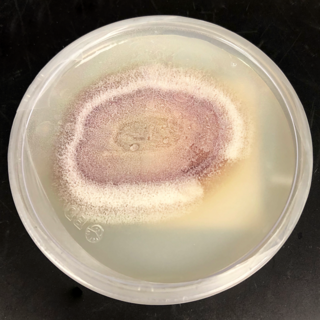Related Research Articles
In mycology, the terms teleomorph, anamorph, and holomorph apply to portions of the life cycles of fungi in the phyla Ascomycota and Basidiomycota:

Nathanael Pringsheim was a German botanist.

Petter Adolf Karsten was a Finnish mycologist, the foremost expert on the fungi of Finland in his day, and known in consequence as the "father of Finnish mycology".
Pichia is a genus of yeasts in the family Pichiaceae with spherical, elliptical, or oblong acuminate cells. Pichia is a teleomorph, and forms hat-shaped, hemispherical, or round ascospores during sexual reproduction. The anamorphs of some Pichia species are Candida species. The asexual reproduction is by multilateral budding.

Kluyveromyces is a genus of ascomycetous yeasts in the family Saccharomycetaceae. Some of the species, such as K. marxianus, are the teleomorphs of Candida species.
Leslie Pedley was an Australian botanist who specialised in the genus Acacia. He is notable for bringing into use the generic name Racosperma, creating a split in the genus, which required some 900 Australian species to be renamed, because the type species of Acacia, Acacia nilotica, now Vachellia nilotica, had a different lineage from the Australian wattles. However, the International Botanical Congress (IBC), held in Melbourne in 2011, ratified its earlier decision to retain the name Acacia for the Australian species, but to rename the African species.
Charles Baron Clarke was a British botanist. He was born at Andover, the eldest son of Turner Poulter Clarke. He was educated at King's College School, London, and at Trinity and Queens' Colleges, Cambridge. He began the study of law at Lincoln's Inn in 1856 and was called to the bar in 1860. He lectured in mathematics at Presidency College, Calcutta, from 1857 to 1865. Clarke was Inspector of Schools in Eastern Bengal and later of India, and superintendent of the Calcutta Botanical Garden from 1869 to 1871. He retired from the Indian Civil Service in 1887. He was president of the Linnean Society from 1894 to 1896, and was elected a fellow of the Royal Society in 1882. He worked at Royal Botanic Gardens Kew until his death in 1906.

Satakentia liukiuensis, is a species of palm tree. They are endemic to Ishigaki Island and Iriomote Island in the Yaeyama Islands, the south-westernmost of the Ryukyu Islands, Japan. It is the only species in the genus Satakentia.

Julius Oscar Brefeld, usually just Oscar Brefeld, was a German botanist and mycologist.
Setchellanthus caeruleus is a species of pungent shrub with large blue flowers. It is placed alone in the genus Setchellanthus, which is in turn, is placed alone in the family Setchellanthaceae. It is endemic to Mexico.
Dangeardiella is a genus of fungi in the class Dothideomycetes. The relationship of this taxon to other taxa within the class is unknown.
Duboscquella is a genus of dinoflagellates.

Apiospora is a genus of fungi which cause plant diseases. It gives its name to the family Apiosporaceae, which contains a number of other genera. This is historically a name for the teleomorph (sexual) life-cycle stage of the fungus; for some species the corresponding anamorph name is Arthrinium.
Bulleribasidium is a genus of fungi in the family Bulleribasidiaceae. The genus currently contains some eleven species. The type species is a parasite of other fungi, its teleomorph having septate basidia and haustorial cells on its hyphae that connect to the host hyphae. Most species are, however, only known from their yeast states.

Rhizoctonia is a genus of fungi in the order Cantharellales. Species form thin, effused, corticioid basidiocarps, but are most frequently found in their sterile, anamorphic state. Rhizoctonia species are saprotrophic, but some are also facultative plant pathogens, causing commercially important crop diseases. Some are also endomycorrhizal associates of orchids. The genus name was formerly used to accommodate many superficially similar, but unrelated fungi.

Phaeoacremonium is a fungus genus associated with wilt and decline diseases of woody hosts and human infections.
Kuraishia is a genus of two species of ascomycetous yeasts in the family Saccharomycetaceae. The type species Kuraishia capsulata was originally described as a member of Hansenula in 1953.
Phaeoacremonium aleophilum is a fungus species in the genus Phaeoacremonium. It is associated with Phaeomoniella chlamydospora in esca in mature grapevines and decline in young vines, two types of grapevine trunk disease.

Arthrinium is a genus of minute disease-causing fungi which belong to the family Apiosporaceae and which are parasitic on flowering plants such as sedges. These fungi have an anamorphic life cycle stage where spores are produced asexually in structures called conidia and a teleomorphic stage where sexual spores are produced in asci.
The Piskurozymaceae are a family of fungi in the order Filobasidiales. Most species are only known from their yeast states, but some produce filamentous sexual states with basidia that are parasitic on other fungi. The family currently contains two genera.
References
- ↑ Togninia (Calosphaeriales) is confirmed as teleomorph of Phaeoacremonium by means of morphology, sexual compatibility and DNA phylogeny. Mostert L, Crous PW, Ewald Groenewald JZ, Gams W and Summerbell RC, Mycologia, Jul-Aug 2003, volume 95, issue 4, pages 646-659, PMID 21148974
- ↑ Burkhardt, Lotte (2022). Eine Enzyklopädie zu eponymischen Pflanzennamen [Encyclopedia of eponymic plant names](pdf) (in German). Berlin: Botanic Garden and Botanical Museum, Freie Universität Berlin. doi:10.3372/epolist2022. ISBN 978-3-946292-41-8 . Retrieved January 27, 2022.